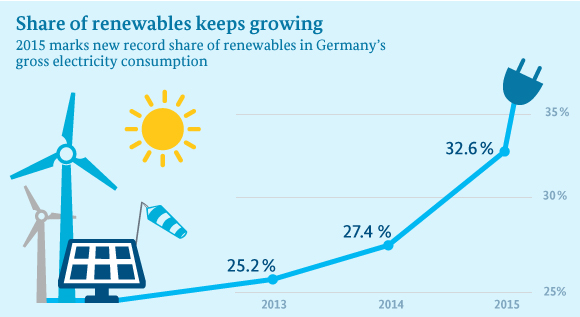Record figures for wind, solar and other renewables
At 32.6 per cent, the share of renewables in Germany's gross electricity consumption reached a new record last year. The figure for 2014 had been 27.4 per cent.
 © BMWi; data provided by the Working Group on Renewable Energy Statistics
© BMWi; data provided by the Working Group on Renewable Energy Statistics
Solar and wind power and other renewables are now accounting for close to a third of Germany's electricity supply. The share of renewables in the country's gross electricity consumption rose to 32.6 per cent last year. This figure has been confirmed by the preliminary data published by the Working Group on Renewable Energy Statistics and commissioned by the Federal Ministry for Economic Affairs and Energy. The figure for 2014 had been 27.4 per cent. This also shows that renewables have strengthened their lead within the German energy mix, ahead of lignite. Overall, close to 196 billion kilowatt hours of electricity was generated from renewables, which is a 20 per cent increase year-on-year.
Strong wind power
Most of the increase in the use of renewables is down to wind power. The amount of electricity generated from wind last year was 88 billion kilowatt hours – that's more than 50 per cent more than the figure for 2014 (57.4 billion kWh). This was thanks to both new capacity being added and good wind conditions. With this massive increase, wind energy continues to be the most important source of renewable energy, accounting for 14.7 per cent of Germany's gross electricity consumption last year – well ahead of biomass (8.3 per cent) and photovoltaics (6.4 per cent).
Major steps towards the 2025 targets
The figures show that the expansion of renewables in Germany is well in step with the government's targets. Renewables are to account for 40 to 45 per cent of Germany's energy consumption by 2025. This figure is to rise to 55 to 60 per cent by 2035, and to at least 80 per cent by 2050.

